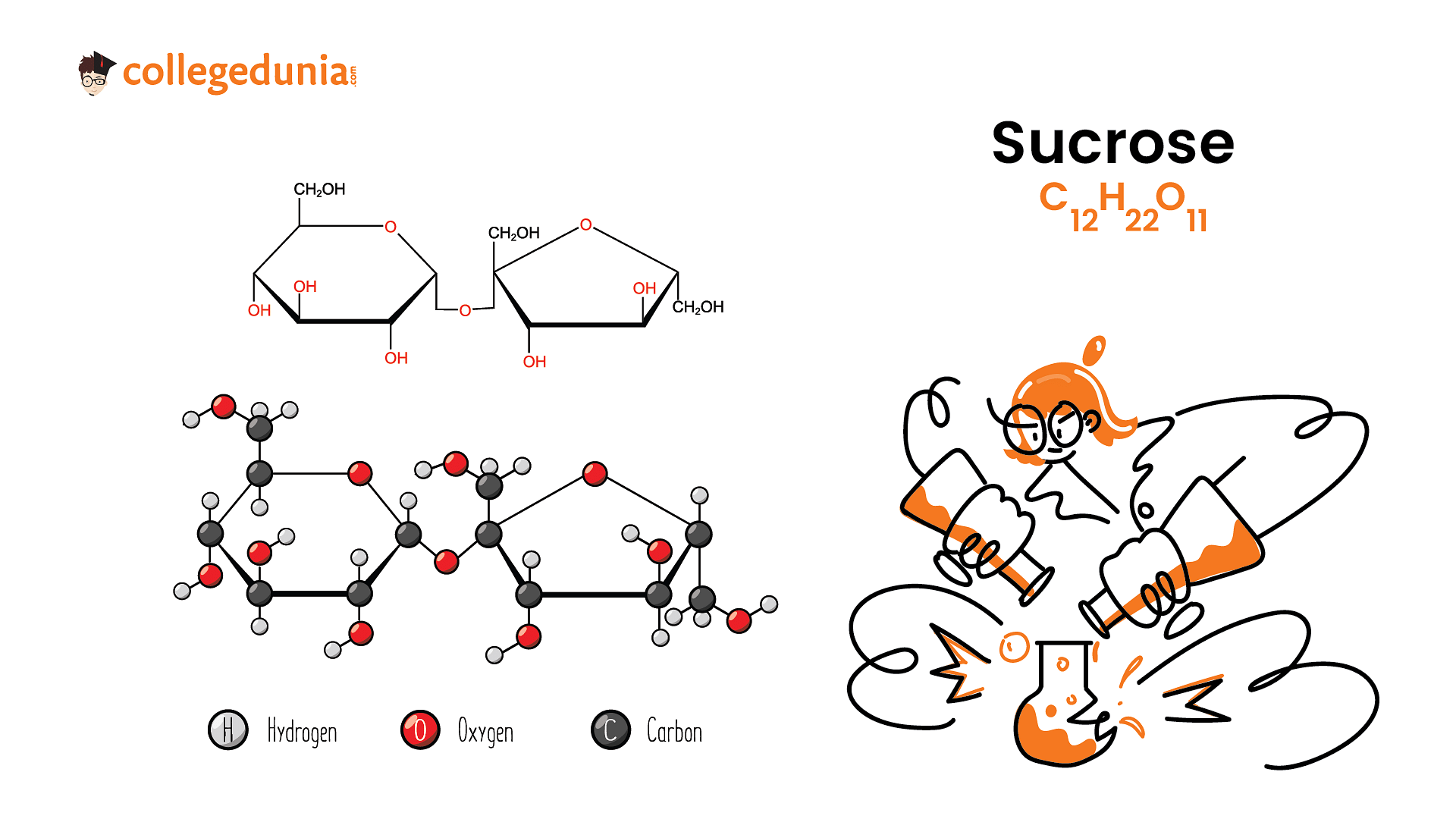Sucrose on hydrolysis gives
- $\beta-D-Glucose$ + $\alpha -D-Fructose$
- $\alpha-D-Glucose + \beta - D - Glucose$
- $\alpha-D-Glucose + \beta -D-Fructose$
- $\alpha-D-Fructose + \beta -D-Fructose$
The Correct Option is C
Approach Solution - 1
The correct answer is Option C) \(\alpha-D-Glucose + \beta -D-Fructose\)
Sucrose is a disaccharide made up of two monosaccharides, namely, glucose and fructose. Sucrose is naturally produced in plants and is refined to form edible table sugar. The molecular formula of sucrose is C12H22O11.
The two monosaccharides in sucrose are held together by glycosidic linkage. Upon hydrolysis, this glycosidic linkage is broken to yield two molecules of \(\alpha\) - D - glucose and \(\beta\) - D - fructose. The reaction can be written as:
\(C_{12}H_{22}O_{11}+H_{2}O \to\underset{\text{D(+)Glucose}}{{C_{6}H_{12}O_{6}}}+\underset{\text{D(-)fructose}}{{C_{6}H_{12}O_{6}}}\)
In expanded form,

Read more from the chapter: Biomolecules
Approach Solution -2
The correct answer is Option C) \(\alpha-D-Glucose + \beta -D-Fructose\)
Real Life Applications
1. Use as Biofuel.
2. Use as sweeteners in food items.
3. Hydrolysis of sucrose produces glucose solution used in the medical industry.
4. Use as a agent to make cosmetics.

Question can also be asked as
- What enzymes are involved in the hydrolysis of sucrose?
- How does the hydrolysis of sucrose differ from its synthesis?
- What is the chemical equation for the hydrolysis of sucrose?
Approach Solution -3
The correct answer is Option C) \(\alpha-D-Glucose + \beta -D-Fructose\)
Sucrose is formed by the combination of two monosaccharides: Glucose and Fructose. The chemical formula of sucrose is C₁₂H₂₂0₁₁. It is commonly known as cane sugar or table sugar.
Properties of Sucrose
- The crystal structure of sucrose is monoclinic.
- The enthalpy of combustion for sucrose is 5647 kJ.mol⁻¹
- On combustion, sucrose forms carbon dioxide and water.
- It can be dehydrated with the help of sulphuric acid.
- There is a glycosidic bond between glucose and fructose
Read more:
Sucrose is formed by the combination of two monosaccharides: Glucose and Fructose. The chemical formula of sucrose is C₁₂H₂₂0₁₁. It is commonly known as cane sugar or table sugar.
Properties of Sucrose
- The crystal structure of sucrose is monoclinic.
- The enthalpy of combustion for sucrose is 5647 kJ.mol⁻¹
- On combustion, sucrose forms carbon dioxide and water.
- It can be dehydrated with the help of sulphuric acid.
- There is a glycosidic bond between glucose and fructose
Read more:
| Related Concepts | ||
|---|---|---|
| Carbohydrates | Glycogen | Maltose |
| Peptide bond | Amino acids | Compounds |
Top Questions on Enzymes
- Which one of the following enzymes contains 'Heme' as the prosthetic group?
- Streptokinase produced by bacterium Streptococcus is used for:
- Describe briefly, the charge relay system that operates in chymotrypsin enzyme.
Match the following
List - A List - B A. Hydrolases I. Argino succinase B. Lyase II. Fructose 1,6 bisphosphatase C. Ligase III. Hexokinase D. Transferase IV. Ribose-5-phosphoisomerase V. Glutamine synthetase The graph showing the concept of activation energy of enzyme is given below. Observe the graph and choose the correct option for M and N.

Questions Asked in NEET exam
- Two identical point masses P and Q, suspended from two separate massless springs of spring constants \(k_1\) and \(k_2\), respectively, oscillate vertically. If their maximum velocities are the same, the ratio of the amplitude of P to the amplitude of Q is :
- NEET (UG) - 2025
- Waves and Oscillations
A sphere of radius R is cut from a larger solid sphere of radius 2R as shown in the figure. The ratio of the moment of inertia of the smaller sphere to that of the rest part of the sphere about the Y-axis is :

- NEET (UG) - 2025
- Moment Of Inertia
- A microscope has an objective of focal length \(f_o = 2\) cm and an eyepiece of focal length \(f_e = 4\) cm. The tube length of the microscope is \(L = 40\) cm. If the distance of distinct vision of eye is \(D = 25\) cm, the magnification in the microscope is:
- NEET (UG) - 2025
- Optical Instruments
AB is a part of an electrical circuit (see figure). The potential difference \(V_A - V_B\), at the instant when current \(i = 2\) A and is increasing at a rate of 1 amp/second is:

- NEET (UG) - 2025
- Electromagnetic Induction and Inductance
- Twins are born to a family that lives next door to you. The twins are a boy and a girl. Which of the following must be true?
- NEET (UG) - 2025
- Genetics